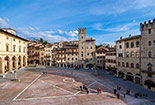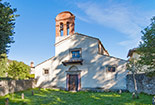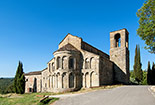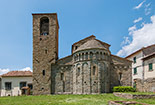PARISH CHURCH OF CHIASSA SUPERIORE.
A church near Arezzo, Tuscan art city that you can know in every detail with this website
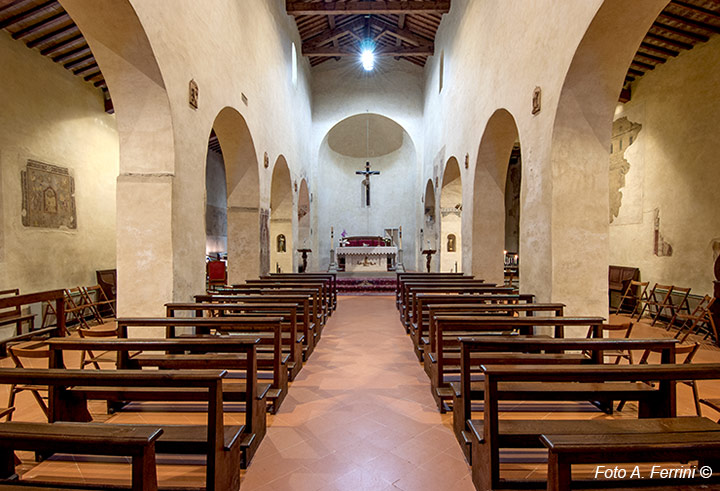
Texts and photos by Alessandro Ferrini ©
33 accurately described images of Church of Chiassa Superiore. Click to elarge
Parish Church of Chiassa Superiore: a treasure chest of art
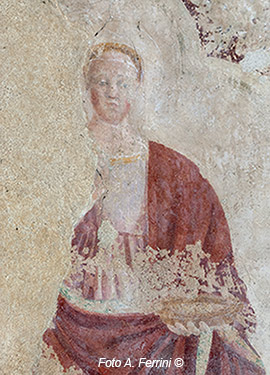 Chiassa Superiore is located a few kilometers north of Arezzo, on the road that leads to Anghiari and Sansepolcro through the Passo della Libbia. In this area there is a splendid Romanesque parish church dedicated to Santa Maria, better known as Pieve della Chiassa Superiore.
Chiassa Superiore is located a few kilometers north of Arezzo, on the road that leads to Anghiari and Sansepolcro through the Passo della Libbia. In this area there is a splendid Romanesque parish church dedicated to Santa Maria, better known as Pieve della Chiassa Superiore.
Perhaps it would be more appropriate to define the pre-Romanesque church as its current construction is dated between the end of the tenth century and the first half of the eleventh century (the bell tower was completely rebuilt in the nineteenth century and the facade was largely rebuilt in the twenties of the twentieth century).
The origins of this religious building, however, can be traced back to the early Christian period, certainly with a smaller and simpler structure. A church that knew the Lombard influence. Proof of this is the clear Lombard style chiselling on various stones incorporated on the inside of the walls of the church. Stones certainly recovered from the previous structure. To remember even more clearly the culture of this people is a pluteus dating from the eighth century, which today is attached to the left wall of the church.
Returning to the current church, its facade immediately suggests that the interior is divided into three naves. As already mentioned, this wall was the subject of a major renovation in the third decade of the twentieth century, an intervention that managed to respect its original appearance. Moving behind the Pieve della Chiassa Superiore we find the rear wall with three apses (which is not common). This important part of the church is not very visible and appears disfigured by the presence of a high bell tower leaning against the central apse and in style completely detached from Romanesque architecture. The tower was built in the 19th century.
Little light inside the Romanesque churches is typical. In this one of the Chiassa Superiore we find even less. Entering we almost go into the dark, a charming 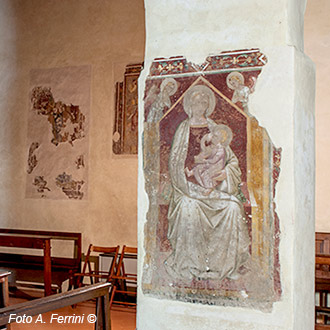 atmosphere. Then, when our pupils are well dilated, we will begin to understand how beautiful the church can offer us. Mighty pillars surmounted by round arches separate the three naves. Everything inside is plastered and painted with lime. This light colour certainly favours visibility, so it is possible to see a large number of frescoes on the walls and pillars. Few are in good condition, some are very faded, others are missing parts. Paintings that can be traced back to the late fourteenth and fifteenth centuries in Arezzo. A large part of the first ones can be traced back to the school of Spinello Aretino. The latter can be attributed to various authors. The most refined of these is certainly the one made inside the left apse: datable to the fifteenth century, it is very close to the style of Piero Della Francesca. It is supposed to be a work of the workshop of one of his students, Lorentino d'Andrea.
atmosphere. Then, when our pupils are well dilated, we will begin to understand how beautiful the church can offer us. Mighty pillars surmounted by round arches separate the three naves. Everything inside is plastered and painted with lime. This light colour certainly favours visibility, so it is possible to see a large number of frescoes on the walls and pillars. Few are in good condition, some are very faded, others are missing parts. Paintings that can be traced back to the late fourteenth and fifteenth centuries in Arezzo. A large part of the first ones can be traced back to the school of Spinello Aretino. The latter can be attributed to various authors. The most refined of these is certainly the one made inside the left apse: datable to the fifteenth century, it is very close to the style of Piero Della Francesca. It is supposed to be a work of the workshop of one of his students, Lorentino d'Andrea.
The paintings, the architecture, the fragments of Longobard sculpture, the pluteus, we will see them, in detail and well described, in the image gallery of this section.
Who designed this church? Several times the name of Maginardo has been given, an architect known in Arezzo for having taken part, between 1006 and 1009, in the restoration of the Old Cathedral, which was located outside the city walls, on the Colle del Pionta. If this were the case, the construction of the Pieve della Chiassa Superiore would have to be traced back to the first decades of the 11th century.



